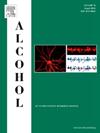艾滋病毒感染者的疼痛和饮酒:检查抑郁和社会支持的调节作用。
IF 2.9
4区 医学
Q3 PHARMACOLOGY & PHARMACY
引用次数: 0
摘要
疼痛和大量饮酒在艾滋病毒感染者(PLWH)中很常见,并且相互影响,随着时间的推移可能会加剧这些情况。本研究考察了有不健康饮酒行为和/或药物使用史的PLWH患者疼痛和酒精使用之间的潜在关联,并测试了抑郁和社会支持是否起到调节作用。来自波士顿酒精研究合作HIV/AIDS队列的233名参与者完成了疼痛强度(即过去一周的平均疼痛严重程度)和疼痛干扰(即日常生活中疼痛的平均干扰),大量间歇性饮酒,饮酒数量,社会支持和基线和6个月后的抑郁症的测量。负二项回归分析评估了基线疼痛是否预测了6个月后的酒精使用情况,并检查了基线社会支持和抑郁作为调节因素。疼痛强度与饮酒次数显著相关(IRR= 1.80, 95% CI: 1.05, 3.08),但与重度饮酒天数无关(IRR= 1.84, 95% CI: 0.83, 4.07),而疼痛干扰与六个月时的饮酒次数(IRR= 1.63, 95% CI: 0.96, 2.75)和重度饮酒天数(IRR= 1.43, 95% CI: 0.64, 3.17)无关。社会支持和抑郁都不是疼痛和6个月酒精使用结果之间关系的显著调节因子。在PLWH中,疼痛强度与更多的酒精使用有关,但与大量饮酒无关。我们的结论是,在考虑干预措施以减少PLWH中的酒精使用时,疼痛是一个需要解决的重要因素。本文章由计算机程序翻译,如有差异,请以英文原文为准。
Pain and alcohol consumption among people living with HIV: examining the moderating roles of depression and social support
Pain and heavy alcohol use are common among people living with HIV (PLWH), and influence one another, potentially exacerbating these conditions over time. This study examines the prospective association between pain and alcohol use among PLWH with a history of unhealthy drinking behaviors and/or substance use and tests whether depression and social support are moderators. A sample of 233 participants from the Boston Alcohol Research Collaborative on HIV/AIDS cohort completed measures of pain intensity (i.e., average severity of pain in the past week) and pain interference (i.e., average interference of pain in everyday life), heavy episodic drinking, number of drinks, social support and depression at baseline and 6 months later. Negative binomial regression analyses assessed whether pain at baseline predicted alcohol use at 6 months, and examined baseline social support and depression as moderators. Pain intensity was significantly associated with number of drinks (IRR = 1.80, 95 % CI: 1.05, 3.08) but not number of heavy drinking days (IRR = 1.84, 95 % CI: 0.83, 4.07), while pain interference was not associated with number of drinks (IRR = 1.63, 95 % CI: 0.96, 2.75) nor heavy drinking days (IRR = 1.43, 95 % CI: 0.64, 3.17) at six months. Neither social support, nor depression were significant moderators of the association between pain and 6-month alcohol use outcomes. Pain intensity is prospectively associated with more alcohol use, but not with heavy drinking among PLWH. We conclude that pain is an important factor to address when considering interventions to reduce alcohol use among PLWH.
求助全文
通过发布文献求助,成功后即可免费获取论文全文。
去求助
来源期刊

Alcohol
医学-毒理学
CiteScore
4.60
自引率
4.30%
发文量
74
审稿时长
15.6 weeks
期刊介绍:
Alcohol is an international, peer-reviewed journal that is devoted to publishing multi-disciplinary biomedical research on all aspects of the actions or effects of alcohol on the nervous system or on other organ systems. Emphasis is given to studies into the causes and consequences of alcohol abuse and alcoholism, and biomedical aspects of diagnosis, etiology, treatment or prevention of alcohol-related health effects.
Intended for both research scientists and practicing clinicians, the journal publishes original research on the neurobiological, neurobehavioral, and pathophysiological processes associated with alcohol drinking, alcohol abuse, alcohol-seeking behavior, tolerance, dependence, withdrawal, protracted abstinence, and relapse. In addition, the journal reports studies on the effects alcohol on brain mechanisms of neuroplasticity over the life span, biological factors associated with adolescent alcohol abuse, pharmacotherapeutic strategies in the treatment of alcoholism, biological and biochemical markers of alcohol abuse and alcoholism, pathological effects of uncontrolled drinking, biomedical and molecular factors in the effects on liver, immune system, and other organ systems, and biomedical aspects of fetal alcohol spectrum disorder including mechanisms of damage, diagnosis and early detection, treatment, and prevention. Articles are published from all levels of biomedical inquiry, including the following: molecular and cellular studies of alcohol''s actions in vitro and in vivo; animal model studies of genetic, pharmacological, behavioral, developmental or pathophysiological aspects of alcohol; human studies of genetic, behavioral, cognitive, neuroimaging, or pathological aspects of alcohol drinking; clinical studies of diagnosis (including dual diagnosis), treatment, prevention, and epidemiology. The journal will publish 9 issues per year; the accepted abbreviation for Alcohol for bibliographic citation is Alcohol.
 求助内容:
求助内容: 应助结果提醒方式:
应助结果提醒方式:


